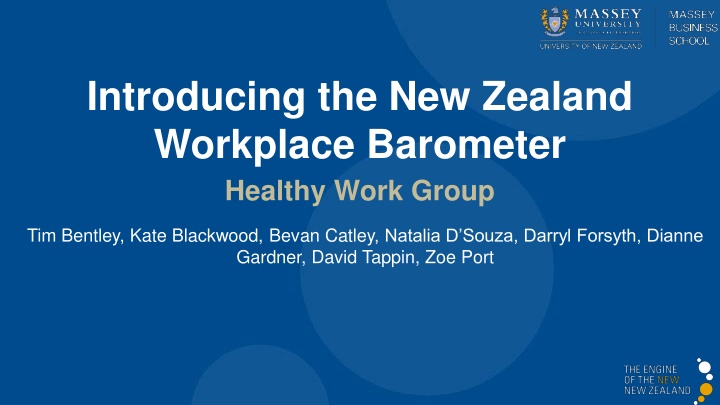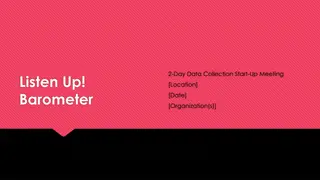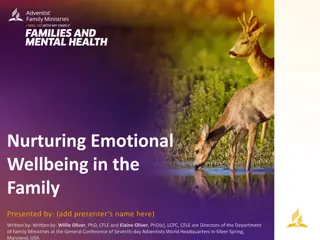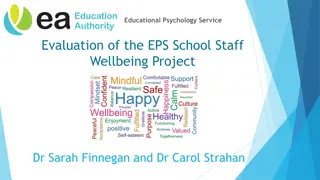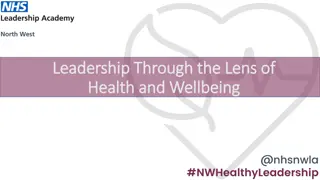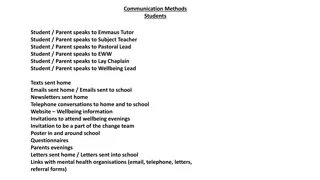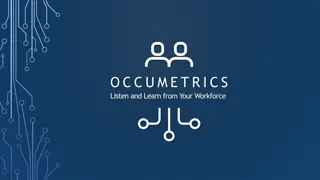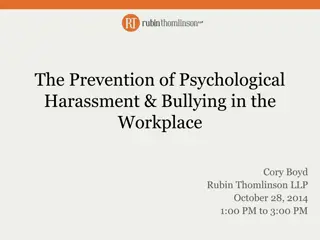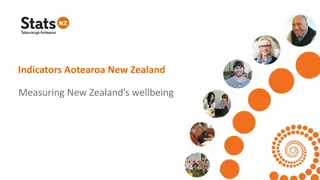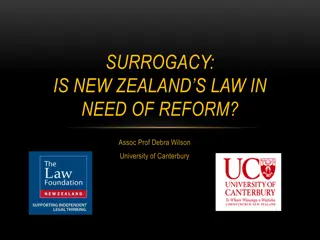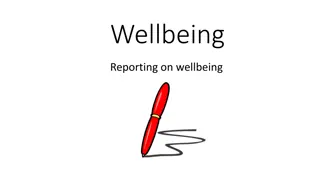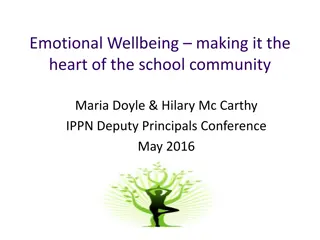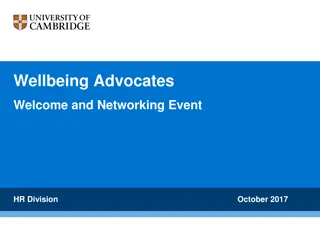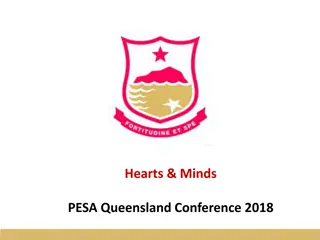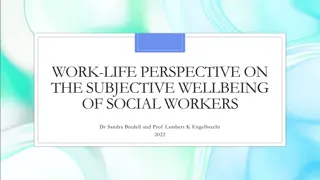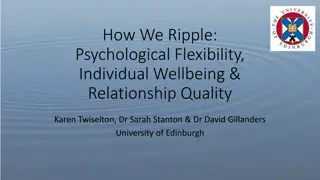New Zealand Workplace Barometer - Psychological Wellbeing Research
Formed in 2009, the Healthy Work Group focuses on psychosocial hazards and risks in NZ workplaces. Discover the impact of work organization on workers' psychological health, and the need for a national monitoring system to address psychosocial risks effectively. Through the NZ Workplace Barometer, longitudinal monitoring will be conducted to study the effects of psychosocial risks on individuals and organizations.
Uploaded on Feb 15, 2025 | 2 Views
Download Presentation

Please find below an Image/Link to download the presentation.
The content on the website is provided AS IS for your information and personal use only. It may not be sold, licensed, or shared on other websites without obtaining consent from the author.If you encounter any issues during the download, it is possible that the publisher has removed the file from their server.
You are allowed to download the files provided on this website for personal or commercial use, subject to the condition that they are used lawfully. All files are the property of their respective owners.
The content on the website is provided AS IS for your information and personal use only. It may not be sold, licensed, or shared on other websites without obtaining consent from the author.
E N D
Presentation Transcript
Introducing the New Zealand Workplace Barometer Healthy Work Group Tim Bentley, Kate Blackwood, Bevan Catley, Natalia D Souza, Darryl Forsyth, Dianne Gardner, David Tappin, Zoe Port
The Healthy Work Group Formed in 2009 to undertake an HRC funded project: Understanding and preventing stress and bullying in NZ workplaces We adopt a multidisciplinary approach to OHS and wellbeing research (OHSW) Underpinning assumption that the social organisation of work is the primary contributor to OHSW problems and their solutions Recognition of social sustainability as a relevant way to talk about OHSW and psychosocial risk to industry https://www.facebook.com/healthyworkgroup/
What are psychosocial hazards and risk? Psychosocial hazards include aspects of work organisation that are a result of human action and have potential to cause psychological harm. These include job design, the organisation and management of work, and relational factors. Changes in the nature of work have potential to increase the risk of psychological harm to workers. Research indicates that New Zealand workers are highly vulnerable to psychosocial workplace problems, placing a considerable burden on the economic and social wellbeing of society. 3
What is Psychosocial Risk? Psychosocial risks Biological risks Incapacity risks Impairment risks Effects of work on health Effects of health on work Two-way relationship Physical risks Ergonomic risks Chemical risks Mobility risks Sensory risks
The rationale for a national psychosocial risk monitoring system Health and Safety at Work Act requires organisations to ensure the physical and mental health of workers NZ has no comprehensive approach to understanding or preventing psychosocial hazards and risk in New Zealand. Need to understand the influence of psychosocial hazards on individual and organisational outcomes for policy and to focus research and intervention. 5
NZ Workplace Barometer NZWB will provide longitudinal monitoring and surveillance of exposure to psychosocial risks among a representative sample of NZ workers. NZWB will examine impacts of psychosocial risk on a range of individual and organisational outcomes. The costs of poor psychosocial safety climate can be estimated. PSC risk (low, medium, high) predicts organisational mental health outcomes.
NZ Workplace Barometer tools Tool Level of inquiry Research strategy Methodology Status NZ Workplace Barometer Longitudinal Study National Quantitative Data collection using on-line survey and telephone interviews Implementation of year 1: Feb, 2018 Psychosocial safety culture assessment tool Organisation Qualitative Focus groups (self- assessment) f2f interviews (researcher assessment) Development and implementation: 2018
NZ Workplace Barometer measures Tool Antecedents Mediators/proximal outcomes Outcomes NZ Workplace Barometer Longitudinal Study Psychosocial safety climate Management competencies Workplace bullying Cyber-bullying Work stress Work-family conflict Depression/mental health Psychological distress Absenteeism Performance Engagement Intention to quit Job insecurity Flexibility Inclusion
Management competencies 1. Respectful and responsible Demonstrate integrity Manage emotions Have a considerate approach 2. Manage/communicate existing and future work Manages work proactively Have good problem-solving skills Participate with and empower others
Management competencies 3. Managing difficult situations Managing conflict Uses the organisation s resources Take responsibility for resolving issues 4. Managing the individual within the team Be personally accessible Be sociable Use empathetic engagement
Potential impact of future forces Future of work Risks to wellbeing Potential outcomes Insecure work Globalisation Stress and anxiety Increasing demands and reduced control New organizational forms Depression and mental health concerns New ways of working Reduced meaning in work Casualisation of work Physical health impacts Interpersonal relationship conflict Growing service sector Absenteeism Demographic shifts Work-family conflict Performance impacts Greater workforce diversity Reduced engagement Social isolation Reduced staff retention Reduced support Automation of jobs Reputational risks Lack of personal development Multiple careers
NZ Workplace Barometer future of work and NZ context Tool Future related factors assessed Working remotely Flexible hours Casualisation job security Ageing workforce NZ specific factors NZ Workplace Barometer Longitudinal Study Maori and Pacifica SME context Multi-cultural diversity Union density
Psychosocial safety culture assessment measures Tool Aspects of psychosocial safety Levels of maturity/advancement Psychosocial safety culture assessment tool (NZWB) Top management commitment and prioritisation Psychological health and safety communication Psychosocial risk reporting Employee involvement Interpersonal relationships Job content Demands and control Career and personal development Generative Proactive Calculative Reactive Pathological
NZWB research model Healthy Work Group Healthy Work Group, Government and industry stakeholders Identific- ation of priority areas for attention National surveillance of psycho- social risk Applied research Intervention Healthy Work Group, Research collaborators Government Industry/organisations Healthy Work Group, Research collaborators
Discussion time Your feedback Your partnership Your interest Your ideas Your connections Your investment Your involvement
